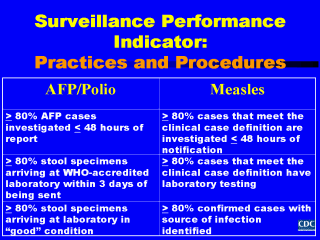 |
The second type
of surveillance performance indicator is one which evaluates how well desired practices
and procedures of a surveillance system are carried out to ensure that cases are
investigated and appropriate laboratory specimens collected in a timely fashion. In our
example concerning surveillance for cases of AFP and measles, the surveillance system is
adequately adhering to recommended practices and procedures if at least 80% of cases
reported to the surveillance system have: 1) case investigations initiated in a timely
fashion; 2) appropriate laboratory specimens, when needed, collected for case
confirmation; 3) specimens arrive at the proper diagnostic laboratory in good condition
and in a timely fashion for testing; and 4) laboratory test results in identification of
the source of infection. Performance indicators similar to these could be used to assess
practices and procedures focused on surveillance of exposures to environmental and
occupational toxicants, while those focused on chronic diseases could have laboratory
components focused on proper and timely collection and identification of serum lipid,
glucose, vitamin, and mineral levels. |
